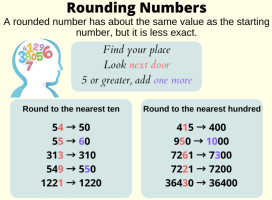Ways to round numbers fall into two categories:
You chose one from the second category. But that much you can’t seem to admit, freely or otherwise.
- Mathematically correct
- Wrong
Types of numerical systems:
1. Base-10/decimal
2. Non-decimal systems, such as Binary/Base-2, Base-3, Base-4, etc. or other bases that use only numeral characters where the "round" numbers do not translate to round Base-10 numbers.
3. Hexadecimal (Base16) or other systems that use a combination of numerals and letters and the "round" numbers in such systems do not translate to round Base-10 numbers.
4. Logarithmic systems based on rational or even irrational numbers (e.g. "natural log" e) that are not decimal based and thus the "round" numbers in such a system do not translate to round Base-10 numbers.
5. Exponential systems based on powers of numbers other than 10 so that the "round" numbers in such a system do not translate to round Base-10 numbers.
6. Vocational systems based on the most commonly used values that are not all "round" Base-10 numbers, such as photographic lens focal lengths such as 24mm, 35mm, 50mm, 70mm, 85mm, 100mm, 105mm, 135mm, 150mm, 180mm, etc.
7. Systems based on multiples of irrational numbers such as π or φ, so that "round" numbers such as 2π or φ+1 do not translate to round Base-10 numbers.
8. Coinage systems with coins which are not multiples of 10 of the base unit. For example, 23 cents would round up to 25 cents, rather than down to 20 cents. 7 cents would round down to 5 cents, rather than up to 10 cents.
You're being entirely too self-limiting by insisting that numbers with more than only a first significant digit not divisible by 10, 100, 1000, etc. are round numbers.
Upvote
0




